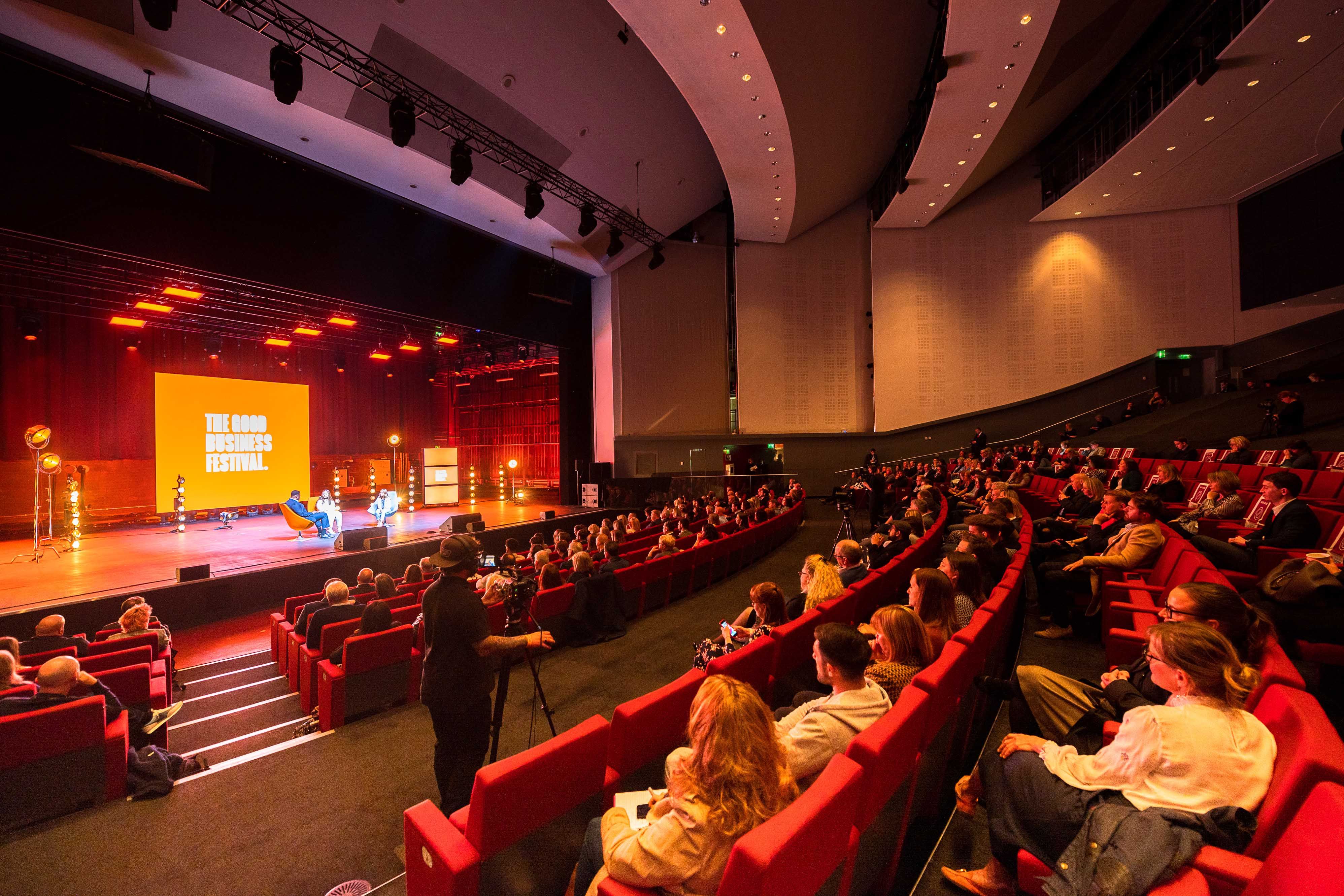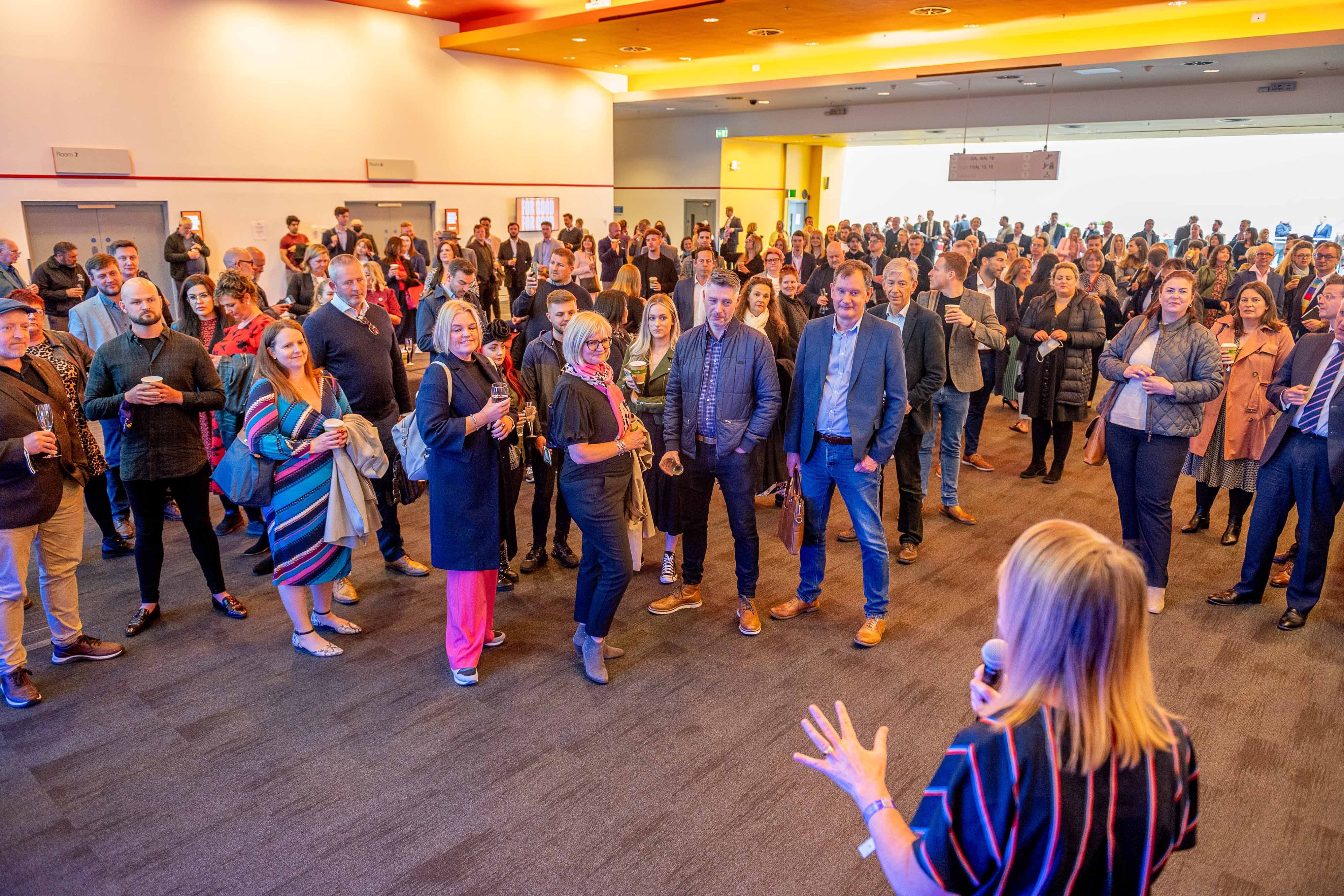Pilot business event: editor's review

For those of you who follow either me, Conference News or Exhibition News on social media, you will have found yourself bombarded with video content and updates on Wednesday 28 April as I reported live from the Good Business Festival at ACC Liverpool – the Government’s (to date) only pilot business event.
For the purpose of this summary, let us park the Good Business Festival and concentrate solely on the pilot element. For the record, the GBF was a marvellous event with great content, and you can read more about that here.
The event formatThe pilot was a conference in typical format. It began with a reception followed by a short welcome address before 400 or so delegates filed through into ACC Liverpool’s auditorium for five sessions. Afterwards, delegates returned to the lobby area to mingle, make use of the open bar (remember those?) and enjoy some light snacks before heading back into the auditorium to enjoy the exploits of a stand-up comedian to wrap up the occasion. It was enjoyably normal.
Before the event, I was under the impression that there would have been an exhibition element to it, but it seems as though I was one of a few who had thought that, and frankly, once I learned the true purpose of the pilot, it became clear why it didn’t necessarily matter. More in a minute.
The process
You will be pleased to know that aside from getting myself a lateral flow Covid test 24 hours before the event, there was nothing to suggest the experience was anything other than ‘normal’.
The day before, I visited a local pharmacy in Surrey where I put a stick up my nose and by the time I had got back to the car I had received a text message telling me I had tested negative, much to my relief. Proactively, I tried to link this test to my NHS Track and Trace app, but without luck. Apparently, you can only log your test result on the app when provided with a code by Government. Since I’d rather have pulled my teeth out with a pair of pliers than enquire further, I proceeded armed only with the text message confirming my good health.
On the day of the event I lived the delegate experience, catching an early train to Liverpool with a cup of warm grit in hand. Upon arriving at the venue, I had to present myself to a small portacabin outside to sign in as a member of the press and collect my badge (which was just a piece of paper – there were no conventional badges). I flashed my test-text at the man out of courtesy.
From this point on, there was no suggestion there was – or had been – a pandemic. Upon entering the venue I had my laptop bag searched and passed through the security gate in the normal way. I deposited my coat in the cloakroom and headed up the escalator to the reception lobby where I was confronted with a group of people smiling, chatting, and all without masks.
The only word to describe it is ‘normal’.
TestingAs stated, I was tested the day before the event, and as a matter of courtesy I shall have myself tested again at the weekend. However, as I was a member of the press, I followed a different procedure to the ‘registered’ Event Research Programme delegates. They too had a lateral flow test the day before, but also on the morning of the event, too. They will also require a PCR test a few days after the event, which will be monitored by the Department for Culture, Media and Sport. “Transmissibility is not expected,” said the lead professor. We wait and see…
But what about those tasked with setting up the event? Well, the production team, contractors and event staff needed to be tested every day during the event set up. I don’t know how many days it took, but testing was carried out in the neighbouring exhibition centre, with test results taking up to 30 minutes. Whether that is something that can feasibly carry over into the real world remains to be seen, but to reiterate what I said on Twitter on the day: nothing taking place during the pilot would determine anything final.

What is the point of the pilot?
I think there has been a bit of misunderstanding about what the pilot events hope to achieve, so I will try and keep this as simple as possible. There is no doubt from Government or the scientists about our capacity to run safe events, that is not, and never was, in question: it is the behavioural trends of delegates and to assess the real-world practicalities of things like testing and added ventilation.
This was not about events as we run them, but how people behave when they are there.
In the media briefing before the event began, professor Iain Buchan, from the Institute of Population Health at the University of Liverpool, who was overseeing the event, made one point abundantly clear: “don’t act artificially,” he said. He and his science team wanted to see us mingle without social distancing, we were encouraged to shake hands, kiss and cuddle if we so fancied. (Of course, if anyone wasn’t comfortable with that, there was no obligation).
This is why it didn’t matter there was no exhibition or hybrid element: it was to study people. It made no difference whether they were walking aisles or filing to an auditorium.
Professor Buchan told the BBC it was “heartening” to see people reconnect, but the organisers were also looking for lessons to learn. “We want to start cautiously with venues like this that are easy to reconfigure... looking at movement in the venues, are there any bottlenecks we can do something about? Is our ventilation really working?”
He said delegates were not compelled to be mask-free as part of the pilot event but to practice “good citizenship” and added they were not expecting to find transmission of the virus.
During the media briefing, I questioned the professor about how the findings would carry over to other venues. Let’s face it, the ACC Liverpool is a big, modern, well ventilated venue with multiple access points and oodles of space. But, I said, 80% of business events are far smaller affairs taking place in often older, smaller venues. One of the City of London’s Livery Halls, for which many don’t even have windows, may find it harder to comply with any ventilation guidance. Professor assured me that they would be fine, and the learnings would carry over.
Results?Let’s nip this in the bud: remove the notion of ‘results of the pilot’. There was no checklist test in the conventional sense, certainly with regards to the operations of the event. The point of the pilot was to give observing scientists a real-life case study of how we behave ourselves at all stages of a typical business event cycle.
The findings will be looked at and a series of recommendations made to Government on what guidance events will need to follow post 21 June. These recommendations won’t be presented until the week leading up to that date, as I understand.
The Government want events to be able to run without the need for face coverings or social distancing from 21 June: so how can they ensure this? That’s the point of the pilot.
This might – might! – mean the need for the temporary requirement of Covid-status certification: either proof of vaccination, proof of a recent negative test, or proof of natural antibodies. Or, the scientists might advise that such things aren’t needed at all, we don’t know. It depends how feasible it is, on the grounds of both cost and practicality.
They want to see risk assessments, so organisers and venues will need to work collaboratively with local health authorities… on what exactly I don’t know, but that’s what people said.
If you need to know, the data will be analysed at four UK universities: Edinburgh, Loughborough, Liverpool and UCL as part of the Event Research Programme. This pilot, along with the other confirmed events, will be viewed collectively and inform the recommendations to Government.
Let us be careful on the rhetoric. I don’t think it’s a case of scientists liking or disliking elements, it’s simply an observation to lead to a recommendation.

There were supposed to 1,000 people!
No, there weren’t. The event had permission to go up to 1,000 people, but there were about 400 or so in attendance on the day. Once you realise that this was a behavioral study you realise it doesn’t matter. Four hundred people is still a good sample size for the purposes of this test.
I was asked if the ‘lower’ number in attendance was the result of the event being effectively unrestricted, and whether I thought more people would have come if the usual mitigation measures were in place: no, I don’t think that. There is no suggestion 1,000 people were invited in the first place, and judging by the amount of chairs available in the auditorium, they seemed to be on target with 400.
What about retail?!What about it? Retail is retail, not events. No, they don’t have to jump through the same hoops, but let us concentrate on us. Don’t forget, there is still a chance you may be asked to wear masks in shops after 21 June, so they have their own issues to overcome. We are moving towards no restrictions at all.
More pilot business events possibleI have it on good authority that the DCMS are interested in conducting further pilot business events between now and first week of June. No doubt these would give scientists further opportunities to study the habits of the common delegate. Nothing has been confirmed either way as yet.
Was it all for show?Good question. Like I said, take nothing away from the Good Business Festival: that was a successful event in its own right, and a massive well done to ACC Liverpool for putting it on. But as for the pilot: yes, I think part of it is for show.
The Government wants events to run after 21 June without masks, social distancing or a cap on numbers, so they need to be able to point to some manner of science to back this up. If Covid-status certification is what it takes as per the scientist’s recommendation, then that is what will be required. There are questions over cost and defining how long ‘temporary’ actually is, but on the premise that neither of these factors are prohibitive, it might be a price worth paying.
On matters such as ventilation, I will be honest when I say I think it came across as a red herring. A big modern venue with multiple access points can be well ventilated, but a converted underground bath house cannot, yet the latter is free to open for business on 21 June too – so expect any guidance to be just about vague enough to let organisers and venues make “risk assessed decisions” on their own.
Was it worth it?Yes. The event was as close to normal as you could have expected. There were no floor marking to keep people in channels, no grumpy stewards in hi-viz jackets barking orders to stay in the herd, no masks, and no social distancing. The people were happy – genuinely, very happy – the content was great, including an inspiring speech from our good friend tourism minister Nigel Huddleston, and the prosecco tasted good. If I need to show a negative test or vaccine card to get in again, I probably would.
Let us just keep our feet on the ground for now.
